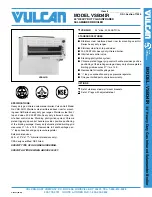
5.
Remove all plumbing fittings to the header. This
will include both inlet and outlet water pipe unions
and the pressure relief valve and drain piping.
6.
Remove limits, control bulbs and/or thermocou-
ples.
7.
Remove the six (or 8) flange nuts and the in/out
header from the left-hand side.
8.
Remove the six (or 8) flange nuts and the return
header from the right-hand side.
9.
Remove the header stud bolts from each tube
sheet.
10. Reverse the headers and stud bolts to the new
location.
11. Install NEW red beveled O-rings flush against both
tube sheets with the bevel facing outward.
12. Push the header firmly against the O-rings. Install
and tighten the flange nuts onto the stud bolts until
finger tight.
13. Slowly tighten the flange nuts, starting from the
center nut (number 1) in Fig. 9 and working se-
quentially around the header as indicated. Torque
all nuts to 25 ft/lb.
DO NOT OVER-TIGHTEN.
14. Re-route the capillary(s), wiring etc. to the new
location, adding thermal paste and shim to the
capillary well.
Relief Valve Piping
WARNING:
Pressure relief valve discharge piping
must be piped near the floor and close to a drain to
eliminate the potential of severe burns. Do not pipe
to any area where freezing could occur. Refer to
local codes.
Hydrostatic Test
Unlike many types of heaters, this heater does not re-
quire hydrostatic testing prior to being placed in
operation. The heat exchanger has already been fac-
tory-tested and is rated for 160 psi operating pressure.
However, Raypak does recommend hydrostatic test-
ing of the piping connections to the heater and the rest
of the system prior to operation. This is particularly
true for hydronic systems using expensive glycol-
based anti-freeze. Raypak recommends conducting
of not less than 1 in.
2
for each 30,000 BTUH mm
2
per kW) of total rated input of the burner(s), and
the location of the opening(s) shall not interfere
with the intended purpose of the opening(s) for
ventilation air referred to in (1). This opening(s)
can be ducted to a point not more than 18 in. (450
mm) nor less than 6 in. (152 mm) above the floor
level. The duct can also “goose neck” through the
roof. The duct is preferred to be straight down 18
in. (450 mm) from the floor, but not near piping.
4.
Refer to B149 Installation code for additional infor-
mation.
Water Piping
General
The heater should be located so that any water leaks
will not cause damage to the adjacent area or struc-
tures.
Reversing Water Connections
Follow these instructions to change the water connec-
tions from the left-hand side (standard) to the
right-hand side.
1.
Disconnect all electrical power from the heater (if
applicable).
2.
Label all electrical connections and conduit lines.
This may include the flow switch, low water cut-off
probe and/or pump.
3.
Disconnect or isolate the main gas pipe from the
heater (if applicable).
4.
Remove both in/out and return header access
panels by removing all sheet metal screws.
CAUTION:
This heater requires forced water
circulation when the burner is operating. See Table
G and Table H for minimum and maximum flow rates
and water pump selection. The pump must be
interlocked with the heater to prevent heater
operation without water circulation.
NOTE:
Minimum pipe size for in/out connections is
2
1
⁄
2
in (2 in. for 399B–899B). Verify proper flow rates
and ΔT as instructed in this manual.
14
Содержание 399B-2339B
Страница 23: ...23 Fig 20 2 Stage Wiring Connections Fig 21 3 Stage Wiring Connections Fig 22 4 Stage Wiring Connection...
Страница 39: ...Wiring Diagram Models 399B 1259B 39...
Страница 40: ...Wiring Diagram Models 1529B 2339B 40...
Страница 52: ...www raypak com Raypak Inc 2151 Eastman Avenue Oxnard CA 93030 805 278 5300 Fax 805 278 5468 Litho in U S A...















































